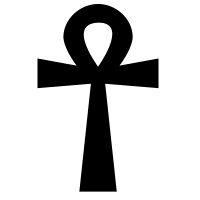Ankh
(Ank). An Egyptian hieroglyphic symbol of life or immortality. It is sometimes called crux ansata (Lat.). Some authorities suggest that the figure is a stylized version of a drawing of an Egyptian mud-anchor as used by Nile boats.
It is described as an “ansated cross” and is depicted as in the accompanying illustration.
It may have been used by early Christians before the crux immissa or “Latin Cross” was adopted; it has been found on Coptic Christian monuments.
Blavatsky offers an interpretation of the Ankh as “The man crucified in space.” She sees the circle as a human head and the cross symbolizing space (CW X:59). An interesting discussion regarding the historical connection between the Tau and the Christian Latin cross may be found in Blavatsky’s Isis Unveiled (IU II:253).
It is now often used as a lucky charm or amulet, but it is worth noting that in all the ancient Egyptian pictures of royal persons holding the Ankh, it is always carried in the right hand and does not seem to have been worn on the person.
© Copyright by the Theosophical Publishing House, Manila
